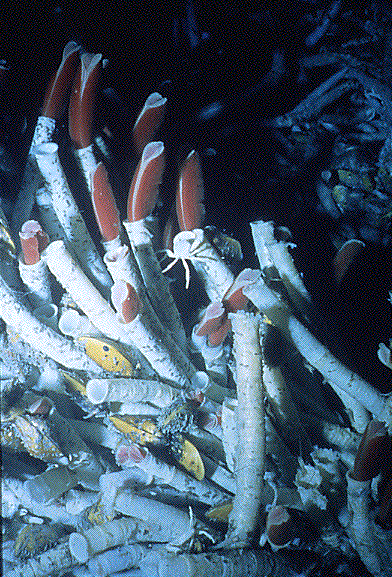How do animals find food in the deep ocean, where there is virtually nothing to stimulate a sensory system? It turns out that many use an organ we're very familiar with - the eye - despite the extremely low level of light present. Most deep-sea vision organs are extremely sensitive. Often, the only light present in the deep ocean is created by very dim bioluminescence - flashes of light produced through a chemical reaction in an organism, much like a firefly. As a result, the eyes of deep-sea creatures are often larger compared to body size than their shallow-ocean or terrestrial cousins, allowing them to collect more light for easier detection. The largest eye-to-body ratio of any animal in the world is found on the Vampyroteuthis infernalis (the vampire squid) - which lives up to 1000 meters under the surface.
Another useful light-sensing adaptation is somewhat more familiar to us than huge eyes. Some deep-sea fish have mirrored surfaces instead of lenses in their eyes. When light hits the mirrored surface, it reflects and focuses, increasing the intensity of light on the biological detector. This allows certain fish, such as the coelacanth and the spookfish, to see very dim flashes of light - which are probably bioluminescent plankton, and therefore food. The mirrored surface is called a tapetum, and it's found in cat and dolphin eyes as well as the recently-discovered spookfish eye.

Mirror, Mirror: Light shined on a spookfish eye reflects and focuses, causing more light to hit the retina. Photo Credit: University of Bristol
The giant isopod, a creepy alien-looking giant pillbug that lives deep underwater, uses eyes familiar to anybody who's seen the classic Jeff Goldblum movie The Fly. Insect eyes are typically compound, meaning that they are segmented over a spherical surface and can see in many directions at once. Compound eyes don't necessarily correlate to better light sensitivity, but they do allow an organism to see in many directions, possibly detecting light another organism may not see because it's not in its more narrow field of vision. Being primarily a scavenger, the giant isopod also uses a sensitive antenna to search the ground around it, but may use its compound eyes for other purposes, such as detecting a predator.

Giant Rolly-Poly: The giant isopod looks like your garden-variety pillbug - only freakishly huge. It sees like many insects, with compound eyes that look in many directions at once. Photo Credit: NOAA
As might be expected in the deep ocean, some organisms don't even use light to sense their surroundings. The tubeworm, which lives around the hydrothermal vents found at tectonic plate boundaries, can only sense and respond to vibration and movement. Tubeworms have a fairly unique adaptation that allows them to survive without constantly ingesting food - in fact, they gain energy by utilizing a symbiotic relationship with bacteria that live inside them. This may be the reason for their primitive sensory system - they don't need to hunt for food, so the only sense they need is a primitve touch sense that allows them to recoil from possible danger.

No Digestion: Tubeworms don't have a digestive tract, and instead live off energy produced by bacteria inside them. As a result, they only have touch as a sense. Photo Credit: UCMP Berkeley
The abundance of light-sensing organs on deep-sea creatures is perhaps the most interesting part of deep-sea ecology. It points to the efficiency and usefulness of the eye, even in situations where an eye would seem useless. As we continue to uncover the mysteries of the deep, we'll hopefully discover some more unique surprises evolution has in store for us.
---
SeaSky's Deep Sea Creatures Page
The Cephalopod Page on the Vampire Squid
See the Coelacanth on NOVA's Creatures of the Deep Page






Comments